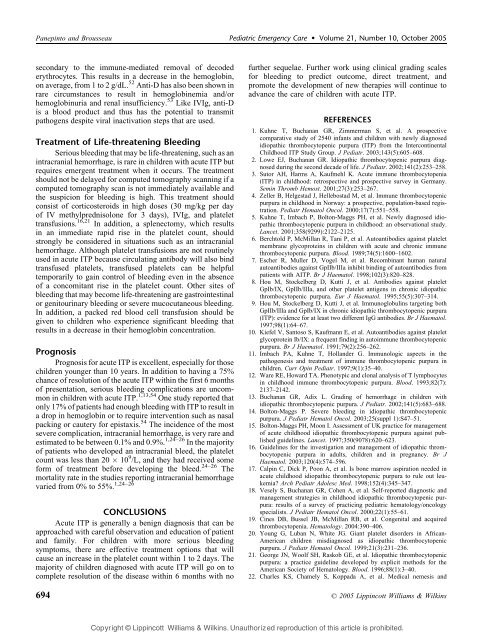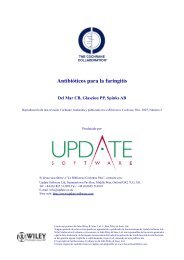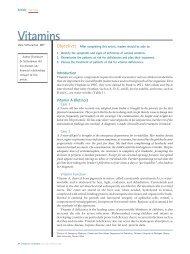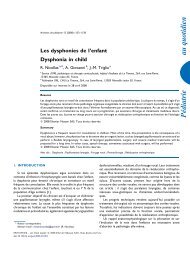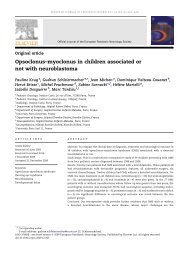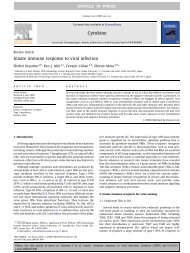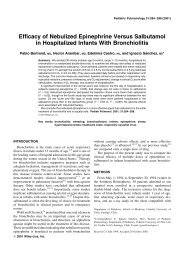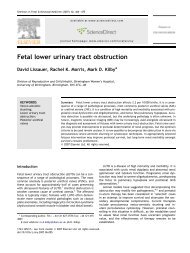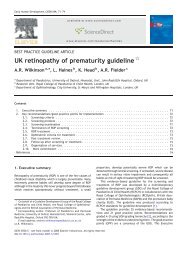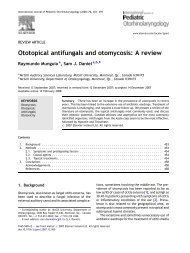Acute Idiopathic Thrombocytopenic Purpura of Childhood ... - sepeap
Acute Idiopathic Thrombocytopenic Purpura of Childhood ... - sepeap
Acute Idiopathic Thrombocytopenic Purpura of Childhood ... - sepeap
You also want an ePaper? Increase the reach of your titles
YUMPU automatically turns print PDFs into web optimized ePapers that Google loves.
Panepinto and Brousseau Pediatric Emergency Care Volume 21, Number 10, October 2005<br />
secondary to the immune-mediated removal <strong>of</strong> decoded<br />
erythrocytes. This results in a decrease in the hemoglobin,<br />
on average, from 1 to 2 g/dL. 52 Anti-D has also been shown in<br />
rare circumstances to result in hemoglobinemia and/or<br />
hemoglobinuria and renal insufficiency. 53 Like IVIg, anti-D<br />
is a blood product and thus has the potential to transmit<br />
pathogens despite viral inactivation steps that are used.<br />
Treatment <strong>of</strong> Life-threatening Bleeding<br />
Serious bleeding that may be life-threatening, such as an<br />
intracranial hemorrhage, is rare in children with acute ITP but<br />
requires emergent treatment when it occurs. The treatment<br />
should not be delayed for computed tomography scanning if a<br />
computed tomography scan is not immediately available and<br />
the suspicion for bleeding is high. This treatment should<br />
consist <strong>of</strong> corticosteroids in high doses (30 mg/kg per day<br />
<strong>of</strong> IV methylprednisolone for 3 days), IVIg, and platelet<br />
transfusions. 16,21 In addition, a splenectomy, which results<br />
in an immediate rapid rise in the platelet count, should<br />
strongly be considered in situations such as an intracranial<br />
hemorrhage. Although platelet transfusions are not routinely<br />
used in acute ITP because circulating antibody will also bind<br />
transfused platelets, transfused platelets can be helpful<br />
temporarily to gain control <strong>of</strong> bleeding even in the absence<br />
<strong>of</strong> a concomitant rise in the platelet count. Other sites <strong>of</strong><br />
bleeding that may become life-threatening are gastrointestinal<br />
or genitourinary bleeding or severe mucocutaneous bleeding.<br />
In addition, a packed red blood cell transfusion should be<br />
given to children who experience significant bleeding that<br />
results in a decrease in their hemoglobin concentration.<br />
Prognosis<br />
Prognosis for acute ITP is excellent, especially for those<br />
children younger than 10 years. In addition to having a 75%<br />
chance <strong>of</strong> resolution <strong>of</strong> the acute ITP within the first 6 months<br />
<strong>of</strong> presentation, serious bleeding complications are uncommon<br />
in children with acute ITP. 1,13,54 One study reported that<br />
only 17% <strong>of</strong> patients had enough bleeding with ITP to result in<br />
a drop in hemoglobin or to require intervention such as nasal<br />
packing or cautery for epistaxis. 54 The incidence <strong>of</strong> the most<br />
severe complication, intracranial hemorrhage, is very rare and<br />
estimated to be between 0.1% and 0.9%. 1,24–26 In the majority<br />
<strong>of</strong> patients who developed an intracranial bleed, the platelet<br />
count was less than 20 10 9 /L, and they had received some<br />
form <strong>of</strong> treatment before developing the bleed. 24–26 The<br />
mortality rate in the studies reporting intracranial hemorrhage<br />
varied from 0% to 55%. 1,24–26<br />
CONCLUSIONS<br />
<strong>Acute</strong> ITP is generally a benign diagnosis that can be<br />
approached with careful observation and education <strong>of</strong> patient<br />
and family. For children with more serious bleeding<br />
symptoms, there are effective treatment options that will<br />
cause an increase in the platelet count within 1 to 2 days. The<br />
majority <strong>of</strong> children diagnosed with acute ITP will go on to<br />
complete resolution <strong>of</strong> the disease within 6 months with no<br />
further sequelae. Further work using clinical grading scales<br />
for bleeding to predict outcome, direct treatment, and<br />
promote the development <strong>of</strong> new therapies will continue to<br />
advance the care <strong>of</strong> children with acute ITP.<br />
REFERENCES<br />
1. Kuhne T, Buchanan GR, Zimmerman S, et al. A prospective<br />
comparative study <strong>of</strong> 2540 infants and children with newly diagnosed<br />
idiopathic thrombocytopenic purpura (ITP) from the Intercontinental<br />
<strong>Childhood</strong> ITP Study Group. J Pediatr. 2003;143(5):605–608.<br />
2. Lowe EJ, Buchanan GR. <strong>Idiopathic</strong> thrombocytopenic purpura diagnosed<br />
during the second decade <strong>of</strong> life. J Pediatr. 2002;141(2):253–258.<br />
3. Sutor AH, Harms A, Kaufmehl K. <strong>Acute</strong> immune thrombocytopenia<br />
(ITP) in childhood: retrospective and prospective survey in Germany.<br />
Semin Thromb Hemost. 2001;27(3):253–267.<br />
4. Zeller B, Helgestad J, Hellebostad M, et al. Immune thrombocytopenic<br />
purpura in childhood in Norway: a prospective, population-based registration.<br />
Pediatr Hematol Oncol. 2000;17(7):551–558.<br />
5. Kuhne T, Imbach P, Bolton-Maggs PH, et al. Newly diagnosed idiopathic<br />
thrombocytopenic purpura in childhood: an observational study.<br />
Lancet. 2001;358(9299):2122–2125.<br />
6. Berchtold P, McMillan R, Tani P, et al. Autoantibodies against platelet<br />
membrane glycoproteins in children with acute and chronic immune<br />
thrombocytopenic purpura. Blood. 1989;74(5):1600–1602.<br />
7. Escher R, Muller D, Vogel M, et al. Recombinant human natural<br />
autoantibodies against GpIIb/IIIa inhibit binding <strong>of</strong> autoantibodies from<br />
patients with AITP. Br J Haematol. 1998;102(3):820–828.<br />
8. Hou M, Stockelberg D, Kutti J, et al. Antibodies against platelet<br />
GpIb/IX, GpIIb/IIIa, and other platelet antigens in chronic idiopathic<br />
thrombocytopenic purpura. Eur J Haematol. 1995;55(5):307–314.<br />
9. Hou M, Stockelberg D, Kutti J, et al. Immunoglobulins targeting both<br />
GpIIb/IIIa and GpIb/IX in chronic idiopathic thrombocytopenic purpura<br />
(ITP): evidence for at least two different IgG antibodies. Br J Haematol.<br />
1997;98(1):64–67.<br />
10. Kiefel V, Santoso S, Kaufmann E, et al. Autoantibodies against platelet<br />
glycoprotein Ib/IX: a frequent finding in autoimmune thrombocytopenic<br />
purpura. Br J Haematol. 1991;79(2):256–262.<br />
11. Imbach PA, Kuhne T, Hollander G. Immunologic aspects in the<br />
pathogenesis and treatment <strong>of</strong> immune thrombocytopenic purpura in<br />
children. Curr Opin Pediatr. 1997;9(1):35–40.<br />
12. Ware RE, Howard TA. Phenotypic and clonal analysis <strong>of</strong> T lymphocytes<br />
in childhood immune thrombocytopenic purpura. Blood. 1993;82(7):<br />
2137–2142.<br />
13. Buchanan GR, Adix L. Grading <strong>of</strong> hemorrhage in children with<br />
idiopathic thrombocytopenic purpura. J Pediatr. 2002;141(5):683–688.<br />
14. Bolton-Maggs P. Severe bleeding in idiopathic thrombocytopenic<br />
purpura. J Pediatr Hematol Oncol. 2003;25(suppl 1):S47–51.<br />
15. Bolton-Maggs PH, Moon I. Assessment <strong>of</strong> UK practice for management<br />
<strong>of</strong> acute childhood idiopathic thrombocytopenic purpura against published<br />
guidelines. Lancet. 1997;350(9078):620–623.<br />
16. Guidelines for the investigation and management <strong>of</strong> idiopathic thrombocytopenic<br />
purpura in adults, children and in pregnancy. Br J<br />
Haematol. 2003;120(4):574–596.<br />
17. Calpin C, Dick P, Poon A, et al. Is bone marrow aspiration needed in<br />
acute childhood idiopathic thrombocytopenic purpura to rule out leukemia?<br />
Arch Pediatr Adolesc Med. 1998;152(4):345–347.<br />
18. Vesely S, Buchanan GR, Cohen A, et al. Self-reported diagnostic and<br />
management strategies in childhood idiopathic thrombocytopenic purpura:<br />
results <strong>of</strong> a survey <strong>of</strong> practicing pediatric hematology/oncology<br />
specialists. J Pediatr Hematol Oncol. 2000;22(1):55–61.<br />
19. Cines DB, Bussel JB, McMillan RB, et al. Congenital and acquired<br />
thrombocytopenia. Hematology. 2004:390–406.<br />
20. Young G, Luban N, White JG. Giant platelet disorders in African-<br />
American children misdiagnosed as idiopathic thrombocytopenic<br />
purpura. J Pediatr Hematol Oncol. 1999;21(3):231–236.<br />
21. George JN, Woolf SH, Raskob GE, et al. <strong>Idiopathic</strong> thrombocytopenic<br />
purpura: a practice guideline developed by explicit methods for the<br />
American Society <strong>of</strong> Hematology. Blood. 1996;88(1):3–40.<br />
22. Charles KS, Chamely S, Koppada A, et al. Medical nemesis and<br />
694 n 2005 Lippincott Williams & Wilkins<br />
Copyright © Lippincott Williams & Wilkins. Unauthorized reproduction <strong>of</strong> this article is prohibited.


